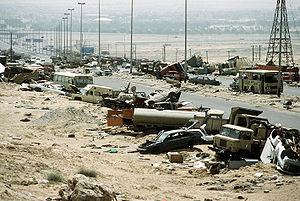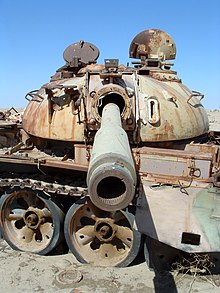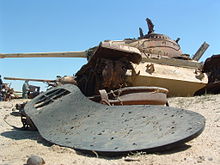Highway of Death
| Highway of Death | |||||||
|---|---|---|---|---|---|---|---|
| Part of the Gulf War | |||||||
 Fragment of the "Mile of Death" in April 1991 | |||||||
| |||||||
| Belligerents | |||||||
|
|
| ||||||
The Highway of Death refers to a road between Kuwait and Basra on which retreating units of the Iraqi army, Palestinian militiamen, and Kuwaiti civilians,[citation needed] were attacked and completely destroyed by American aircraft during the United Nations Coalition offensive in the Gulf War, on the night of February 26 - February 27, 1991.
It is known officially as Highway 80, and it runs from Kuwait City to the border towns of Abdali (Kuwait) and Safwan (Iraq), and then on to Basra. The road was repaired during the late 1990s, and was used in the initial stages of the 2003 invasion of Iraq by U.S. and British forces.
Aerial strikes
Airstrikes were conducted on two different sections of highway: some 1,400 vehicles on the main highway north of Al Jahra (the "actual" Highway of Death) and another 400 or so on the much-less known coastal road to Basra.
On the main highway, aircraft bombed the front and rear of the massive vehicle column, trapping the convoy, and leaving sitting targets for later strikes. When visited by journalists the main highway had been reduced to a long uninterrupted line of destroyed, damaged, and abandoned vehicles, sometimes called the Mile of Death. The wreckage predominantly consisted of stolen civilian vehicles (such as cars, trucks, and buses) which were manned by Iraqi Army conscripts and allied Palestinian militiamen aligned to the PLO (no evidence has been provided of any armed PLO in the vicinity). A large portion of the vehicles were manned by Iraqi civilians who had been encouraged to loot Kuwaiti property. This was eagerly carried out due to the scarcity of food and fuel in Iraq after the onset of war since the Iraqi regime failed to create reservesCivilian Looters.
On the coastal road, known as the place of the Battle of the Junkyard, vehicles of the elite Iraqi Republican Guard division had been destroyed over a much larger area in smaller groups, and attacking Allied ground forces played a role in the attack, including elements of the U.S. 3rd Armored Division. The vehicles, practically every one of which was destroyed, were predominantly military and had belonged to the Republican Guards' "Hammurabi" 1st Armored Division.
Controversies


The offensive action for which the road is infamous became a controversial point, with some commentators alleging that the use of force was disproportionate, as the Iraqi forces were retreating and the column included Kuwaiti prisoners of war and political prisoners as well as the Palestinian civilian refugees.[citation needed] Some argued that the Iraqi regulars were on the verge of mutiny, and that the attack on them actually helped the regime of Saddam Hussein to stay in power.[citation needed]
Although no reporters were present during the action, and media accounts did not appear for almost a month, photographs taken afterwards showed dramatic scenes of burned and broken vehicles. The bombings were cited by some observers as a "war crime" — the deliberate bombing of a stretch of highway where fleeing and out-of-combat Iraqi troops were stuck in a frenzied traffic jam.[citation needed]
The U.S. military, however, stated that only a few dead bodies were found in the wreckage and that most of the occupants had abandoned their vehicles when the road became impassable. According to a PBS FRONTLINE interview with American journalist Rick Atkinson, when asked whether we know how many Iraqis were killed on the Highway of Death, he answered:
I don't think we'll ever know how many Iraqis were killed there. There were about 1,500 vehicles on the highway of death, counted, destroyed vehicles after the war. And another 400 or so on another road, a spur that ran parallel to the coast. Those who wandered through this wreckage right after the Iraqi surrender found relatively few bodies. Certainly some, and many that were terribly incinerated of those that were found. But the prevailing view is that many of the Iraqis had simply gotten out of their vehicles and ran. And it's difficult to believe that deaths on the highway of death probably exceeded more than a couple of hundred perhaps.
Major General Mark Welsh, USAF [1], in a 1999 speech describing his Gulf War experiences to Air Force cadets [2], paints a different picture of where personnel on the ground was when U.S. aircraft began strafing and bombing the stopped convoy.
I’m sure I’d killed people before during the war, but this time I saw ’em. I saw the vehicles moving before the bombs hit. I saw soldiers firing up at me, then running as I dropped my bombs to make sure they wouldn’t get away.
According to the then Chairman of the Joint Chiefs of Staff and former Secretary of State Colin Powell, the "shooting gallery" scenes of carnage was the reason to end the Gulf War hostilities after the liberation of Kuwait. "The television coverage was starting to make it look as if we were engaged in slaughter for slaughter's sake," Powell wrote later in My American Journey.
According to the Foreign Policy Research Institute, however, "appearances were deceiving":[3]
Postwar studies found that most of the wrecks on the Basra roadway had been abandoned by Iraqis before being strafed and that actual enemy casualties were low. Further, opinion surveys showed that American support for the war was largely unaffected by the images. (Arab and Muslim public opinion was, of course, another matter, about which Powell may have been rightly concerned.)
Photojournalist Peter Turnley published photographs of mass burials at the scene;[4] it has been asserted that this constituted a violation of the Geneva Conventions.[5]
Peter Turnley also wrote an essay to Dirck Halstead, the editor and publisher of The Digital Journalist stating:
I flew from my home in Paris to Riyadh when the ground war began and arrived at the “mile of death” very early in the morning on the day the war stopped. Few other journalists were there when I arrived at this incredible scene, with carnage that was strewn all over. On this mile stretch were cars and trucks with wheels still turning and radios still playing. Bodies were scattered along the road. Many have asked how many people died during the war with Iraq, and the question has never been well answered. That first morning, I saw and photographed a U.S. military “graves detail” burying many bodies in large graves. I don’t recall seeing many television images of these human consequences. Nor do I remember many photographs of these casualties being published.
This suggests that the lack of bodies found on the scene was due to "graves detail" as suggested by one of the first reporters on the scene.
In popular culture
- The film Jarhead contains a scene of the Highway of Death.
- Footage of the Highway was seen in the music video of Iron Maiden's Afraid to Shoot Strangers from their album Fear of the Dark.
References
- ^ Mark Welsh Biographie
- ^ Mark Welsh, Speech to Cadets
- ^ Photojournalism and Foreign Affairs David D. Perlmutter Foreign Policy Research Institute January 27, 2005 Accessed October 26, 2007
- ^ The Unseen Gulf War. Peter Turnley, Harvard University Nieman Reports, Spring 2003.
- ^ The Persian Gulf TV War. Douglas Kellner, UCLA, July 10, 2006. Retrieved October 24, 2007.
External links
- The Unseen Gulf War - A DigitalJournalist Multimedia Exposure by Peter Turnley
- PBS Frontline's "The Gulf War"
- An article in the Baltimore Sun, just before the second Gulf War, including a description of Highway 80
- An article in The Daily Telegraph, during the war, including a map
- An article in Stars and Stripes, contrasting the condition of the road in 1991 and 2003
- Photographs of destroyed military equipment taken by a contemporary American serviceman
- A high-resolution map of Kuwait. Highway 80 leads north from Kuwait city, via al-Jahra
- Clip from a CBC news broadcast depicting the incident's aftermath
